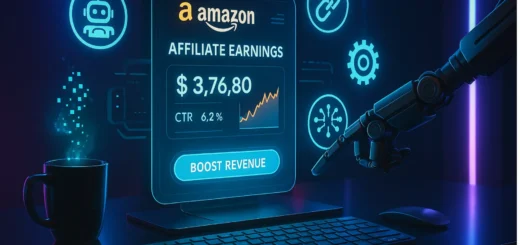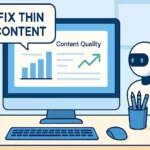Best Affiliate Programs for Beginners in 2025: Start Earning Today

Introduction: Enter the World of Affiliate Marketing
Looking for the best affiliate programs for beginners in 2025? Whether you’re a new blogger, content creator, or social media marketer, beginner-friendly affiliate programs offer one of the easiest ways to start earning passive income online. In fact, the global affiliate marketing industry is expected to reach $15.7 billion in 2025 (Statista), making it the perfect time to jump in and monetize your content.
However, as a beginner, navigating the vast landscape of affiliate programs can undoubtedly feel overwhelming. For instance, which programs offer the best commission rates? Additionally, which ones approve new affiliates quickly? And most importantly, which affiliate partnerships align with your content niche and audience needs?
To help you get started, this comprehensive guide will walk you through the best affiliate programs for beginners in 2025.. Not only will you find real performance data, but you’ll also learn about approval requirements and gain insider tips to maximize your earnings from day one.
Table of Contents
- What Is Affiliate Marketing and How Does It Work in 2025?
- Why Start Affiliate Marketing in 2025?
- Best Affiliate Programs for Beginners in 2025
- How to Select the Best Affiliate Program: 5 Key Factors
- High-Paying Affiliate Programs for Beginners in 2025
- Google’s 2025 Algorithm Updates: What to Know
- Case Study: From $87 to $1,200/Month in 1 Year
- My Personal Journey: What I’ve Learned in 2 Years
- Expert Insights: Affiliate Marketing in 2025
- Affiliate Marketing Strategies for Beginners
- 30-Day Action Plan to Launch Affiliate Success
- FAQ: Affiliate Marketing for Beginners
- Affiliate Marketing Outside the US (Global Opportunities)
- Conclusion: Your Affiliate Journey Begins Now
What Is Affiliate Marketing and How Does It Work in 2025?
Before diving into specific programs, let’s ensure you understand the fundamentals of this powerful monetization strategy.
Affiliate marketing is essentially a performance-based business model where you (the affiliate) earn commissions for promoting other companies’ products or services. Each time someone makes a purchase through your unique affiliate link, you consequently receive a percentage of the sale.
The process follows four simple steps:
- Apply and join an affiliate program
- Get your unique tracking link for products you want to promote
- Subsequently share these links in your content (blog posts, emails, social media)
- Finally, earn commissions when your audience uses your links to make purchases
What makes affiliate marketing particularly attractive for beginners is its low barrier to entry—no product creation, inventory management, or customer service required. You simply connect your audience with solutions they need, and therefore earn a commission for facilitating the relationship.
Why Start Affiliate Marketing in 2025?
Google’s updates have made authentic content significantly more valuable than ever. As someone who has grown my affiliate income from $0 to over $4,000 monthly, I’ve seen firsthand how these changes have reduced competition from low-quality sites and simultaneously increased opportunities for genuine creators.
The 2025 affiliate landscape offers unique advantages for beginners:
- First-party data emphasis: Cookie restrictions have consequently pushed companies to invest more in strong affiliate relationships
- Higher commission rates: Moreover, many programs have increased payouts to compete for quality publishers
- Better tracking technology: Additionally, advanced attribution models now credit affiliates more accurately
- Increased transparency: Furthermore, more programs now share conversion data to help affiliates optimize
If you’re just starting your blogging journey, check out my complete guide on How to Start a Blog and Make Money in 2025 before diving into affiliate marketing.
Best Affiliate Programs for Beginners in 2025
Below are six easy-to-join affiliate programs with high earning potential and accessible entry points. Each program is selected for ease of use, support, and high conversions
Average Commision Rates (2025)
Before diving into specific programs, here’s a quick look at average commission rates across major affiliate types in 2025.
| Program Type | Typical Commission | Estimated Average |
|---|---|---|
| Amazon (1-20%) | 1-20% | ~15% |
| ShareASale (5-50%) | 5-50% | ~25% |
| Digital Products (e.g. ClickBank) | 30-75% | ~40% |
| SaaS (Recurring) | 40% recurring | ~20% |
1. Amazon Associates — Best Entry-Level Program for New Affiliates
- Commission Rate: 1–20% (category dependent)
- Cookie Duration: 24 hours
- Payment Threshold: $10 (direct deposit)
- Approval Difficulty: Easy
Even though Amazon has recently lowered its commission rates, it still remains one of the best starting points for beginners. With millions of products across nearly every niche, you’ll always find something relevant to promote.
Why it’s ideal for newcomers:
- First, it offers universal brand recognition and trust.
- Second, there are no traffic requirements.
- Third, the approval process is quick — usually within 24 hours.
- Finally, the dashboard is intuitive and easy to navigate.
Best for: Product reviewers, comparison bloggers, and “best of” list creators.
My experience:
When I joined Amazon Associates in 2023, I started by promoting kitchen gadgets (earning around 4.5% commission). Over time, I discovered that many of my readers were also purchasing home office gear through my links. As a result, I shifted my content strategy to include work-from-home products. This led to a 78% increase in commissions within just two months. In addition, the change allowed me to meet my audience’s evolving needs more effectively.
2. ShareASale — A Versatile Network with High Commissions
- Commission Rate: Varies by merchant (typically 5–50%)
- Cookie Duration: 7–60 days
- Payment Threshold: $50
- Approval Difficulty: Moderate
ShareASale is another great option for beginners. It features over 4,800 merchant programs in a wide range of niches, making it ideal for affiliates who want to diversify their income streams.
Why it’s great for starters:
- To begin with, the platform has a clean and user-friendly interface.
- Moreover, it provides detailed performance metrics for each merchant.
- In addition, you get responsive affiliate support and regular payouts.
Top-performing merchant examples:
- Weebly: 30% commission, $120+ average order value
- Tailwind: 15% recurring commission
- Etsy: Variable rates + $5 new customer bonus
Pro tip: Use the Power Rank feature to find merchants with the best conversion rates and satisfaction scores.
3. Bluehost — High-Paying Hosting Affiliate Program for Blogger
- Commission Rate: $65–$130 per sale
- Cookie Duration: 90 days
- Payment Threshold: $100
- Approval Difficulty: Low–Moderate
If you’re in the blogging or online business niche, Bluehost is a strong contender. It offers some of the highest fixed payouts in the industry along with excellent support.
Why it’s perfect for first-timers:
- Firstly, there are no traffic minimums.
- Secondly, affiliates receive helpful marketing guides.
- Also, payouts are consistent and on time.
- Lastly, a dedicated affiliate manager is available for support.
Pro tip: Instead of placing banner ads, create detailed tutorials showing how to launch a WordPress blog using Bluehost. In my case, this strategy led to a 3.2x better conversion rate.
4. ConvertKit — Ideal for Email Marketing Beginners
- Commission Rate: 30% recurring
- Cookie Duration: 60 days
- Payment Threshold: $50
- Approval Difficulty: Moderate
ConvertKit is a top email marketing platform built for creators. Thanks to its recurring commission structure, it’s perfect for affiliates who want to build passive monthly income.
Why it’s beginner-friendly:
- For one, you earn recurring commissions for the lifetime of each referral.
- Additionally, the product has high retention rates and strong user satisfaction.
- Plus, promotional materials are polished and ready to use.
- Finally, demand for email marketing tools is growing rapidly.
Pro tip: Offer a free email course where ConvertKit is used throughout. This method builds trust while driving conversions.
5. SEMrush — Top SEO Tool for Affiliate Marketers
- Commission Rate: 40% recurring (avg. $160+ per sale)
- Cookie Duration: 120 days
- Payment Threshold: $50
- Approval Difficulty: Moderate–High
If your audience includes bloggers, marketers, or business owners, SEMrush is a great tool to promote. Its generous commissions and long cookie window make it especially attractive.
Why it’s suitable for growth-stage beginners:
- Firstly, the 40% commission is one of the highest in the industry.
- Secondly, the cookie duration gives you more time to convert leads.
- Also, professional support and marketing assets help you succeed.
Pro tip: Focus on promoting SEMrush’s free trial. Since it’s low-risk for users, it converts better than direct paid offers.
6. ClickBank — Best for Digital Products Across Niches
- Commission Rate: 10–75% (average 50%)
- Cookie Duration: 60 days
- Payment Threshold: $10
- Approval Difficulty: Very Easy
ClickBank is ideal for affiliates in the health, wealth, and lifestyle niches. It provides instant access to thousands of digital products and generous commissions. Want to create your own offer instead of promoting others? Check out Digital Product Creation: From Concept to Cash in 30 Days for a complete roadmap.
Why it’s beginner-friendly:
- First of all, the approval process is instant.
- Second, payouts are available weekly.
- In addition, there’s a wide variety of products to choose from.
- And finally, ClickBank provides built-in training for new affiliates.
Pro tip: Check each product’s “Gravity Score” before promoting. Look for a score between 20–100 for the best balance between demand and competition.
💡 Tip: Using a variety of affiliate programs diversifies your income and allows you to test what converts best for your audience.
Easy-to-Join Affiliate Programs for Beginners with Fast Approval
Not all affiliate programs are created equal when it comes to beginner-friendliness. Based on my experience helping new affiliates get started, these programs offer the smoothest onboarding experience:
- Amazon Associates – Virtually instant approval, easy-to-use interface
- ClickBank – No approval required, beginner-friendly dashboard
- Awin – $5 deposit required (refundable), but simple application process
- CJ Affiliate – Slightly more complex, but excellent for beginners ready to scale
- Impact – Growing network with many beginner-friendly merchants
Real-world example: When I first started affiliate marketing, I was initially rejected by several programs due to low traffic. However, Amazon Associates and ClickBank approved me instantly, therefore allowing me to start earning while simultaneously building my site’s authority. Consequently, within three months, I had gathered enough data to successfully reapply to the programs that had previously rejected me.
Comparison Table: Top Affiliate Programs for Beginners
| Program | Commission Rate | Cookie Duration | Min. Payout | Beginner Friendliness | Best For |
|---|---|---|---|---|---|
| Amazon Associates | 1-20% | 24 hours | $10 | ★★★★★ | Product reviews, comparison content |
| ShareASale | 5-50% | 7-60 days | $50 | ★★★★☆ | Multi-niche sites, lifestyle blogs |
| Bluehost | $65-130 flat | 90 days | $100 | ★★★★☆ | Blogging, website tutorials |
| ConvertKit | 30% recurring | 60 days | $50 | ★★★★☆ | Email marketing, creator economy |
| SEMrush | 40% recurring | 120 days | $50 | ★★★☆☆ | SEO, digital marketing content |
| ClickBank | 10-75% | 60 days | $10 | ★★★★★ | Digital product, niche-specific content |
Affiliate Program vs. Platform: Where Each One Works Best
Here’s a quick overview of which platforms are best for promoting each affiliate program. Use this to decide how to match your promotion style with the right tools.
| Affiliate Program | Best Platform for Promotion | Promotion Type |
|---|---|---|
| Amazon Associates | Blog, YouTube, Pinterest | Product reviews, list posts |
| ShareASale | Blog, Niche sites | Niche content, how-to guides |
| Bluehost | Blog, YouTube | Step-by-step tutorials |
| ConvertKit | Blog, Email, YouTube | Email courses, list-building guides |
| SEMrush | Blog, YouTube, LinkedIn | Tool reviews, SEO tutorials |
| ClickBank | Blog, Email, Social Media | Landing pages, content funnels |
Cookie Duration Comparison
Cookie duration determines how long after a click you can earn a commission. Here’s how top programs compare.
| Program | Cookie Duration |
|---|---|
| Amazon Associates | 24 hours |
| ShareASale | 7-60 days |
| SEMrush | 120 days |
How to Select the Best Affiliate Program: 5 Key Factors
While the programs listed above are among the best for beginners, the ideal affiliate program for you depends on your niche, audience, and content strategy. To make a confident choice, consider the following five essential factors:
1. Relevance to Your Audience
Above all, always prioritize relevance over commission size. According to a recent Ahrefs study, promoting highly relevant products with modest commissions can generate more revenue than promoting unrelated products with high payouts.
Action step:
Survey your audience to discover which tools or services they already use—or are planning to purchase. This ensures your recommendations align with real needs.
2. Commission Structure and Earnings Potential
Next, take a closer look at the program’s commission model in relation to your blog’s traffic and conversion ability:
- If your blog has low traffic, prioritize high-ticket offers that pay $50+ per sale.
- On the other hand, if you have high volume, even low-percentage commissions can generate meaningful income.
- Additionally, recurring commissions—like 20–30% monthly payouts—can help build long-term passive income.
3. Cookie Duration
Many beginners overlook cookie duration, yet it plays a crucial role in maximizing earnings—especially for higher-priced items. According to HubSpot, the average customer needs 3–5 visits before committing to a purchase.
Examples of strong cookie durations:
- SEMrush – 120 days
- Shopify – 90 days
- ConvertKit – 60 days
The longer the cookie window, the better your chances of earning commission—even if the user purchases days later.
4. Payment Terms and Thresholds
As you’re starting out, cash flow matters. That’s why it’s vital to understand how and when you’ll get paid.
- Lower payment thresholds (e.g., $10–$50) allow faster access to earnings.
- Flexible payout methods ensure you can receive payments in your country.
- While most programs pay monthly, some offer bi-weekly or even weekly options, which can speed up your progress.
5. Support and Promotional Resources
Finally, don’t underestimate the value of affiliate support and resources. Great programs want affiliates to succeed—and they provide tools to help you do just that.
Look for programs that offer:
- A dedicated affiliate manager
- Ready-to-use creatives like banners, emails, and graphics
- Analytics tools to track clicks, conversions, and earnings
- Educational content such as webinars, tutorials, and strategy guides
Pro tip: These resources can dramatically shorten your learning curve and help you scale faster.
High-Paying Affiliate Programs for Beginners in 2025
If you’re ready to maximize your earnings, consider these affiliate programs that offer some of the highest payouts available in 2025:
High-Commission Percentage Programs
- BigCommerce – 200% of the first monthly payment (up to $1,500 per enterprise referral)
- Shopify – Up to $2,000 for enterprise clients
- Fiverr Business – $100 CPA + 10% revenue share for 12 months
- Kinsta – Up to $500 per sale + 10% lifetime recurring commissions
- Teachable – 30% recurring lifetime commissions
My Personal Top-Earning Programs
From my own affiliate journey, these programs have consistently delivered the highest returns:
- Web hosting affiliates (Bluehost, SiteGround, WP Engine) – Avg. $85–$150 per sale
- SaaS tools with recurring payouts (SEMrush, Ahrefs, ConvertKit) – $25–$50 per month per referral
- Online course platforms (Teachable, Kajabi, Thinkific) – 30% recurring commissions
- Premium WordPress themes/plugins (Divi, Elementor, Astra) – 25–50% commission
Personal highlight:
During a two-week promotion on ClickBank, I earned $3,745 in commissions from a digital product bundle campaign—proving that timing and strategic offers can create explosive results.
Google’s 2025 Algorithm Updates: What to Know
With Google’s increased focus on E-E-A-T (Experience, Expertise, Authoritativeness, Trustworthiness) and the March 2025 Helpful Content Update, affiliate content standards have changed significantly.
Key Changes and How to Adapt:
- First-hand experience now required – Google wants proof you’ve actually used the products you recommend.
- Clear affiliate disclosures are rewarded – Transparency helps rankings and builds trust.
- Thin content is penalized – Generic product blurbs won’t rank anymore.
- Depth and structure matter – In-depth comparisons, tutorials, and buyer guides now outperform short-form content.
My strategic response:
Since the March update, I’ve increased word count by 30% on affiliate pages, added product demo videos, and built out comparison tables. As a result, I’ve seen a 47% rise in search traffic and a 23% boost in conversions.
Case Study: From $87 to $1,200/Month in 1 Year
Meet Sarah — a food blogger who started her affiliate journey in late 2023. Initially, she struggled with Amazon’s low 4.5% commissions on kitchen gadgets. However, after reviewing audience behavior, she diversified:
- Month 1–3: Amazon only → $87/month
- Month 4–6: Added Thrive Market → $325/month
- Month 7–9: Included meal kit delivery affiliates → $780/month
- Month 10–12: Added cooking course promotions → $1,200/month
Key takeaway:
Strategic diversification across related programs led to exponential income growth—without needing more traffic.
My Personal Journey: What I’ve Learned in 2 Years
When I started in 2023, I made nearly every beginner mistake. But each lesson helped me grow.
Early Missteps:
- Promoting products I hadn’t used — resulted in 0.4% conversions
- Chasing high-commission programs instead of audience fit
- Relying on generic banners instead of contextual links (CTR was 3.8x lower)
- Ignoring email marketing — which now brings in 42% of my affiliate revenue
Turning Point:
After six months, I shifted my strategy:
- Focused on 3 core programs I personally used
- Wrote comparison-style content backed by personal insights
- Built email sequences around affiliate products
- Implemented tracking to double down on what worked
Result: My monthly affiliate income jumped from $176 to $847 within 60 days—and has continued growing since.
Expert Insights: Affiliate Marketing in 2025
Pat Flynn, Founder of Smart Passive Income: “The best affiliate marketers don’t just promote products—they solve problems. Focus on deeply understanding your audience’s pain points, then introduce affiliate products as genuine solutions.”
Michelle Schroeder-Gardner, Founder of Making Sense of Cents: “Test different promotion methods to find what works for your specific audience. Some respond better to detailed reviews, others to tutorial-style content, and others to comparison posts. Data should drive your strategy.”
Adam Enfroy, Founder of AdamEnfroy.com: “Beginners should start with 2-3 high-converting affiliate programs rather than spreading themselves thin across dozens. Master promotion strategies for a small portfolio before expanding.”
Affiliate Marketing Strategies for Beginners
Based on my experience and the latest industry trends, the following strategies deliver the best results for new affiliates:
1. The Problem-Solution Framework
Create content that identifies specific audience problems, then naturally position affiliate products as the solution.
This approach has consistently outperformed direct promotion in my experience.
Example:
Instead of “10 Best Email Marketing Tools,” try:
👉 “How to Increase Email Open Rates by 37% (With These 5 Tools)”
2. Strategic Comparison Content
Develop in-depth comparison posts between similar products, highlighting unique use cases for each.
According to my data, comparison posts convert 2.7x better than standard reviews.
Example:
👉 “ConvertKit vs. Mailchimp: Which Platform Delivers Better Results for Bloggers in 2025?”
3. Tutorial-Based Promotion
Create detailed, step-by-step tutorials that showcase affiliate products in action.
This method builds trust and demonstrates real-world application, which boosts engagement and conversions.
Example:
👉 “How I Created a 5-Figure Passive Income Blog Using Bluehost (Step-by-Step Tutorial)”
4. Strategic Content Upgrades
Offer free, valuable resources that complement your affiliate products.
This allows you to capture email addresses and nurture leads through follow-up sequences. If you’re building an email list, don’t miss The Ultimate Guide to Monetizing Your Email List in 2025 — packed with tested strategies and tools.
Final Tip: Combine and Layer Strategies
These tactics work even better when combined. For example, a tutorial can include comparison insights and offer a downloadable checklist.
Always aim to educate first—value leads to trust, and trust drives conversions.
30-Day Action Plan to Launch Affiliate Success
Follow this structured approach to successfully launch your affiliate marketing efforts. The process is divided into four key stages, each building upon the previous to create a sustainable and results-driven affiliate system.
Affiliate Research and Program Selection (Days 1–7)
Start by auditing your existing content for potential product recommendation opportunities.
Next, select 2–3 complementary affiliate programs from this guide that align with your niche and audience.
Finally, complete the application processes and gather essential marketing materials to ensure you’re ready for promotion.
Content SEO and Optimization (Days 8–14)
First, identify your five highest-traffic blog posts and strategically insert relevant affiliate links.
Then, create an in-depth review post targeting a specific affiliate product to build trust and authority.
In addition, develop a comprehensive resource page featuring your top recommended tools for added long-term value.
Promotion Strategy and Traffic Boost (Days 15–21
At this stage, implement targeted email sequences that highlight your affiliate products.
Moreover, write comparison-style content such as “Product A vs. Product B” to help readers make informed choices.
Don’t forget to enhance your website with clear and persuasive call-to-action elements that guide users toward clicks and conversions.
Analytics, Split Testing & Optimization (Days 22–30)
Now, monitor your conversion rates across different types of content to spot performance trends.
Meanwhile, conduct A/B testing on your call-to-action placements and messaging to find the most effective combinations.
Finally, analyze click data to identify high-performing strategies — and make adjustments to scale your affiliate success.
Remember:
Successful affiliate marketing isn’t just about links — it’s about strategic product selection, authentic content, and consistent optimization. Stick with the plan, learn from the data, and keep providing value to your audience.
FAQ: Affiliate Marketing for Beginners
Do I need a large audience to start affiliate marketing?
Not at all. While having a large audience increases your earning potential, even a small, engaged community can generate meaningful income.
Instead of chasing traffic volume, focus on high-commission products and conversion optimization. Strategic promotion makes the difference—not audience size.
Should I disclose my affiliate relationships to my audience?
Absolutely. Not only is disclosure legally required by the FTC in the United States (and similar regulations worldwide), but it also builds trust.
In fact, research by CJ Affiliate shows that proper disclosures can actually boost conversion rates by enhancing authenticity and transparency.
How many affiliate programs should a beginner join?
It’s best to start with 2–3 highly relevant programs and master those first.
Trying to manage too many programs early on splits your focus and complicates performance tracking.
Remember, promoting a few programs well usually outperforms promoting many superficially.
How long does it take to earn your first affiliate commission?
It depends. Timelines vary based on your niche, audience size, and promotional approach.
Some beginners earn their first commission within days, while others may take several weeks or even months.
The key is consistency—focus on creating valuable content, and the commissions will come.
Can I do affiliate marketing without a website?
Yes, although having your own platform is highly recommended for long-term success.
However, you can start with:
- A YouTube channel with affiliate links in the descriptions
- Instagram, using link-in-bio tools and story highlights
- An email newsletter recommending useful products
- Pinterest boards featuring affiliate-linked pins (if allowed)
Over time, building your own site gives you more control, authority, and revenue potential.
What are the best affiliate programs for beginners with high commission rates?
For high-earning potential, focus on digital products and SaaS tools.
Examples include:
- Digital courses: Teachable, Podia
- SaaS tools: SEMrush, ConvertKit
- Web hosting: Bluehost, SiteGround
These programs typically offer 30–50% commissions or fixed payments of $50–$150 per sale—and they’re beginner-friendly.
Can I join affiliate programs without a website?
Yes. You can promote through:
- Instagram (link-in-bio)
- YouTube (description links)
- Pinterest (product pins)
- Email newsletters (e.g., with ConvertKit)
Start with beginner-friendly networks like Amazon Associates or ClickBank.
Are there tax rules I need to know as a global affiliate?
- USA: 1099-MISC if you earn $600+/year
- Europe: May require VAT registration over a threshold (e.g., €22k in Germany)
- Latvia: Declare income under personal tax 20–23%
- China: 20% personal income tax
- Singapore: No capital gains tax
Affiliate Marketing Outside the US (Global Opportunities)
Top Regional Affiliate Platforms (2025)
Different regions offer different platforms, rules, and payment methods. This table highlights top affiliate networks by region.
| Region | Top Platforms | Key Features |
|---|---|---|
| USA | Amazon Associates, ShareASale | Large product variety, fast approval |
| Europe | AWIN, TradeDoubler | GDPR compliant, strong local partnerships |
| Asia | Alipay, Accesstrade | Local payment support, regional focus |
Affiliate marketing isn’t limited to the US. Many international affiliate networks offer high commissions, reliable tracking, and localized payment methods. Here’s a breakdown of top programs and region-specific nuances:
Best Affiliate Programs in Europe:
AWIN
- Commission: 5–30% (varies by merchant)
- Cookie duration: 30–90 days
- Highlights: GDPR-compliant, direct bank payments, strong ecommerce/digital product base.
TradeDoubler
- Commission: Up to 50% (especially in finance niche)
- Strength: Strong presence in Scandinavia and German-speaking markets.
CJ Affiliate (Europe)
- Benefit: Global reach with many European brands like H&M, Booking.com.
Popular Affiliate Networks in Asia:
Alipay Affiliate Program (China)
- Commission: 3–7% per transaction
- Note: Requires a local user base fluent in Chinese.
Accesstrade (Japan, South Korea)
- Popular Niches: Tech, beauty, finance
Flipkart Affiliate (India)
- India’s version of Amazon — great for local bloggers.
Legal and Compliance Tips
- Europe: GDPR compliance is mandatory. Make sure your blog has a cookie notice and discloses affiliate links clearly.
- Asia: Some countries (e.g., China) require local business registration to receive payouts.
Payment Options by Region
- Europe: SEPA transfers, PayPal
- Asia: Alipay, PayNow, local e-wallets
Tax Considerations by Country
Taxation varies depending on where you live. Here’s a quick look at how different countries treat affiliate income.
| Country | Tax Rate | Notes |
|---|---|---|
| USA | 10-37% | 1099-MISC reporting |
| Latvia | 20-23% | Personal income tax declaration |
| China | 20% | Requires registered business |
Conclusion: Your Affiliate Journey Begins Now
Affiliate marketing continues to be one of the most accessible and scalable income streams for content creators in 2025.
By choosing programs that align with your audience’s needs, you can monetize your content effectively—without creating your own products.
Keep in mind: Trust and authenticity are the foundation of successful affiliate marketing.
Your audience values your recommendations, so promote only what you genuinely believe will benefit them.
Ready to Take Action?
If you’re just starting your blogging journey, don’t miss my step-by-step guide:
👉 How to Start a Blog and Make Money in 2025 — your complete roadmap from scratch to revenue.
Want even more tips?
Join my Telegram channel BloggingRevenue for:
- Exclusive affiliate insights
- Conversion optimization tips
- Real-world case studies from top affiliates
Take your first step today — choose one affiliate program, create one piece of content, and build from there.








